History of Begonia City Ladies Rowing Club
- Introduction
- Background
- After amalgamation
- Brief chronology
- 1971 - The catalyst
- 1972 - Own regatta
- 1973 - Closer ties with Ballarat City RC
- 1974 - Settling down
- 1975 - New members and uniforms
- 1976 - Senior B racing and coaching
- 1977 - Senior A racing and championships
- 1978 - Full amalgamation with Ballarat City RC
- 1979 - First season as Ballarat City RC
- 1980’s - Onward and Upward
- Appendix
1971 – The Catalyst
Beginning of women’s rowing in Ballarat. The wakeup call!
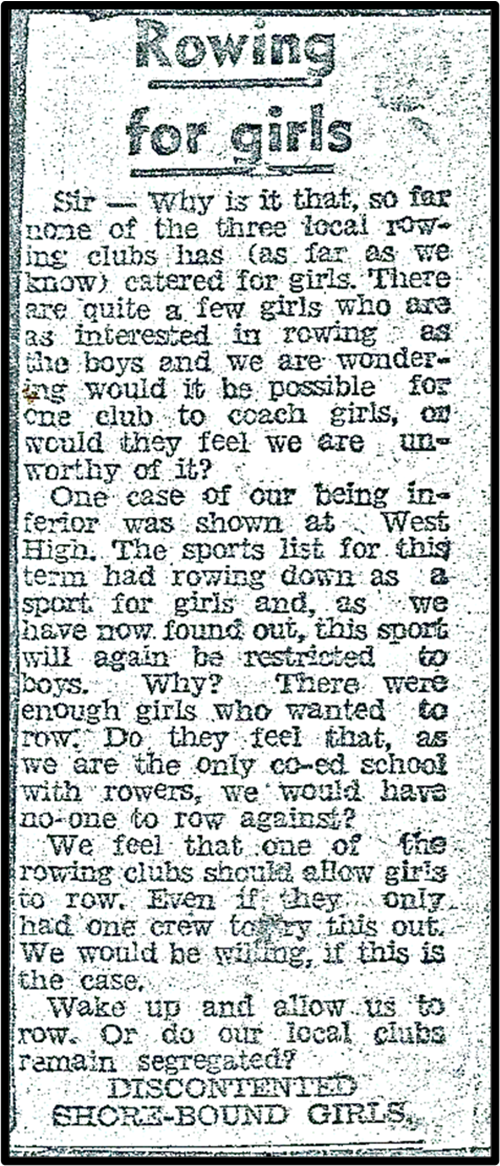
It began with this letter to the Editor of the Ballarat Courier asking the question why there was no opportunity for women to row. It was published on the 25th of February 1971 and was signed “Discontented Shore-bound girls.” It drew attention to the fact the while Ballarat had three rowing clubs, not one of them catered for women.
Rowing had been a bastion of male domination in Ballarat since 1862, over 100 years, and while women had been involved, it was usually at a social and fundraising level. The women, the wives, girlfriends, sisters and daughters of oarsmen, organised and ran fundraising events for each of the three rowing clubs very successfully from the early 1870’s. For example, in the 1930’s the Ballarat City Social Club, which was composed mainly of young women, raised the money for the new boatshed to be built. Several women made generous donations to Ballarat Rowing. Mrs.Ure-Taylor, or Aunty Taylor as she was known, of the Lake View Hotel, was a generous benefactor of rowing in Ballarat and donated money and trophies to all three clubs.
On the rowing front, women had always enjoyed rowing in the various “pleasure boats” on the lake but had not transitioned to competitive rowing. A women’s crew had rowed at Wendouree Rowing Club in 1960, but that was a very brief lasting only a couple of weeks. The Wendouree Rowing Club at that time, certainly didn’t encourage ongoing involvement. Ballarat Courier, 24 February 1971
The letter also stated that Ballarat High School had listed rowing as a sport for girls in 1971 but it was announced by the school that, due to lack of resources, rowing was again to be restricted to boys! The letter sparked considerable interest in the press and several letters of support for the “Shore-bound girls” appeared in subsequent editions of the Ballarat Courier. There were also many rowing men who only saw problems with women rowing. Two days after the Discontented Shorebound girls had their letter printed, another article was printed in response. Jack Barnett, who was president of the Ballarat Rowing Association stated that he thought Ballarat rowing clubs would “never cater for women”! Captain of the Wendouree Rowing Club, who had actually coached a women’s crew in 1960 for a few weeks, said that local rowing clubs had enough problems without having to cater for women rowers.

Ballarat Courier 26th February, 1971, page 14
Denise Widmer, a Ballarat girl, who was rowing at the Melbourne University Ladies Rowing Club wrote a letter supporting the girls. This was published in the Ballarat Courier newspaper a few weeks later on the 13th of March. Denise Widmer was Vice-Captain of MULRC and active rower and raced in their winning intervarsity four of 1971. In her letter of support, she offered helpful advice and an action plan, suggesting they form a club and seek the assistance from the Victorian Ladies Rowing Association. She, along with Pat Oddie, also took the initiative to run a Come and Try Day and get all the interested girls together.
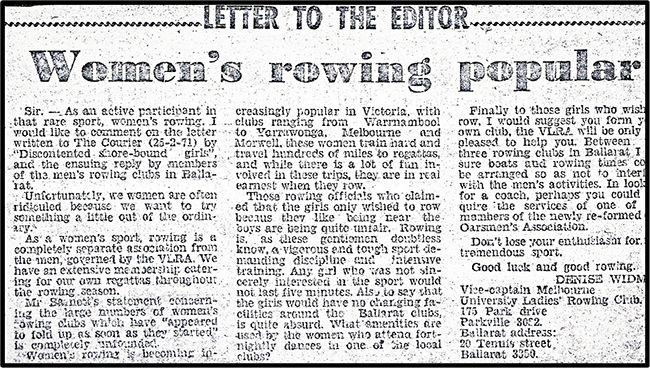
Letter from Denise Widmer to the Editor, Ballarat Courier, 13th March, 1971.
Denise Widmer pointed out in her letter, that statements made by Mr. Jack Barnett, then President of the Wendouree Rowing Club, were very unfair and totally unfounded. He had stated in the newspaper, that women’s clubs were not “sustainable in the long term” and he questioned the motives of those women and girls who wished to row. Any woman who took up rowing in those early days certainly had to battle not only the often misogynistic views of many male rowing administrators but also the public perception that rowing was not really a sport for women.
She encouraged the women of Ballarat who wanted to row to form their own club and advised them to get assistance from the VLRA and to approach the three male clubs, Ballarat Rowing Club, Wendouree Rowing Club and Ballarat City Rowing Club, for help with equipment and coaching. She mentioned specifically Ballarat City Rowing Club as a possible host for the women, as they held a fortnightly dance in the hall and already had the necessary separate toilets and change facilities available for women.
After Denise’s letter was published, several weeks of correspondence to the editor, was published expressing a wide range of opinions on women becoming involved in rowing. The collection of newspaper clippings reveal the both the support and the problems faced trying to establish women’s rowing in Ballarat. Jack Barnett also wrote again to the Editor saying it was “impractical” to have women rowers as there was a shortage of boats and there were no separate facilities for women at the boatsheds.

Letter to the Editor, Ballarat Courier, March 1971
This letter from a “Keen Male Oarsman” answered these concerns, pointing out again that there were actually facilities for women at the Ballarat City Rowing Club and they therefore could quite easily accommodate women. His letter also made the point that membership at male rowing clubs has been in decline, with the oldest of the clubs, Ballarat Rowing Club, on the verge of amalgamating with either Ballarat City or Wendouree. If any one of the men’s clubs hosted a women’s rowing club, it could solve the problem of decreasing membership and revitalise the men’s clubs.
There were further letters of support for the establishment of rowing for women published in the Courier, most agreeing that the lack of “facilities” or change rooms and separate toilets, or the perceived lack of equipment, were all impediments that could be overcome with a little effort. While all three existing clubs didn’t have a lot of equipment, it was mostly being used in the afternoons, so there was the potential to schedule use at other times of the day. And there were many “retired” oarsmen who could teach the women to row. All it needed was a willingness to investigate how it could be done rather than putting forward all the reasons why women could not row. At least the young ladies of the 1970’s were spared the medical advice that it would be dangerous to their health as the young ladies of the 1920’s were told!
The upshot of the interest sparked by the correspondence in the newspaper was the “Come and Try” day was organised and advertised during the August/September school holidays for the 27th of August. About 13 girls turned up, mainly schoolgirls, and some of them from Ballarat High School. Denise Widmer was true to her word and along with Pat (Oddie) Gabb they bought the sport of rowing to the women of Ballarat. Some of the opposition of the male clubs was overcome as the Ballarat Rowing Club loaned them boats and oars for the day.

This small advertisement in the Courier in mid-August headed “WOMEN’S ROWING-Interested?” announced the first of the Learn to Row days to be held.
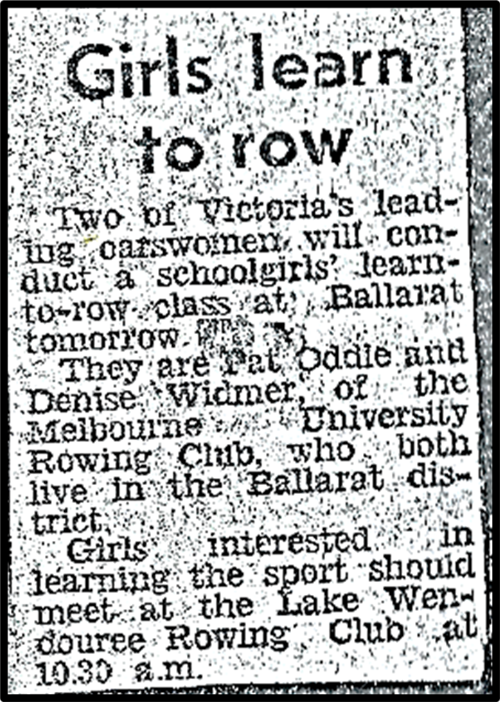
ImageA further recruiting and “Learn to Row” day was held in September at Ballarat High School boatshed. The Victorian Ladies Rowing Association gave lots of support in running these days and helping with equipment and coaching. A couple of weeks later in September the Victorian Ladies Rowing Association members, Kath (Suhr) Bennett, publicity officer, and Caroline Judd hosted another rowing clinic for women at Ballarat Rowing Club boatshed with Ballarat Rowing Club again supplying the equipment.
Photographs and a report of the first “Come and Try” Day appeared in the Ballarat Courier on August 28th, 1971. Interesting to note that all the girls are dressed in jeans and jumpers, as the invitation didn’t specify appropriate rowing apparel!

Photograph from Ballarat Courier August 28th, 1971
Pictured are left to right are; Catherine Walker, Marlene Lakerink, Lynda Gullock and Lois Schmidt. At the front is Aileen Walker being instructed by Denise Widmer.
Other names listed in the article are Pat Oddie, Debra Gowers, Jane Van Dolderen, Susan Van Dolderen and Kim Butler.


Articles from Ballarat Courier, September, 1971.
The Come and Try days went ahead and were a great success. Women officially launched boats onto the hitherto male dominated waters of the beautiful Lake Wendouree. The “Shore-bound Girls” were shore-bound no longer!
Regardless of the difficulties and the lack of support from some of the administrators of all three men’s clubs, the small band of “ladies” were determined not just to row but to establish a club. The small article from the Courier in mid-September alludes to their determination and also mentions that the past efforts to form a women’s rowing club in Ballarat, as having a “bad failure rate.”
Perhaps the “failure” refers to the first women’s crew to row out of Wendouree Rowing Club in 1960. The crew only trained for a couple of weeks and then disappeared. The formation of Begonia City Ladies in 1971 was the first really serious and determined effort to get women into boats and it was thanks to initiative, enthusiasm and drive of that first group of women that they achieved their goal of forming a club.
In the early 1970’s women’s rowing in Victoria was still a “rare” and unusual sport for women. Several older clubs existed in Melbourne such as YWCA, Essendon and the Albert Park Ladies Rowing Club, which had formed in the early 1900’s. Nestles Rowing Club in Warrnambool had also been an early club catering solely for women as had Dimboola Ladies Rowing Club. New clubs trying to get established had to overcome over a century of rowing tradition entrenched in the men’s clubs and as with all change, it wasn’t going to happen quickly
The Victorian Ladies Rowing Association had formed in 1924 and so had been organising and running women’s rowing in Victoria for more than 40 years. During the late 1960’s they became more active in the promotion of women’s rowing, recruiting new members and forming new clubs. They also supporting country areas like Ballarat to get women’s rowing established. They offered practical support in the form of training days, equipment loans and also advice on how to form and run a club.
Begonia City Ladies Rowing Club would be the ninth women’s club to be formed in Victoria. The majority of these clubs were formed in a very short space of time from about 1970 to 1976. It was testament to the “crusading” work done by Kath (Suhr) Bennet and Carolyn Judd of the Victorian Ladies Rowing Association by bringing the opportunity to row to the women of regional Victoria.
From the Begonia City Ladies perspective, it is undoubtedly due to the hard work and determination of Glenda Sheers, a student nurse at the Ballarat Base Hospital that the club did become a reality. Following the Learn to Row days, she took on the role of organising secretary and continued to lobby the local men’s clubs and push for the establishment of the club. The Ballarat Courier publicised the developments and led by Glenda the small group of women persisted until a shed and equipment were made available.
Kim Butler and Lois Schmidt, the two discontented schoolgirls, were the catalyst for women’s rowing being established in Ballarat. They echoed the question asked by women way back in 1912 of “Why not?”-why should women not have the opportunity to row, but as they were schoolgirls and could not take on the formal tasks of setting up and running a club. Glenda Sheers was undoubtedly the main person that led to the successful establishment of Begonia City Ladies Rowing Club.
Following the Come and Try days, sufficient momentum had been gained and the support of the Victorian Ladies Rowing Association had been demonstrated, so the next step was taken to actually inaugurate a rowing club for women. The club was to take its name from Ballarat’s famous floral emblem, the begonia, and so Begonia City Ladies Rowing Club or BCLRC was constituted. The club’s colours were to be a maroon t-shirt with a white star. They would be a separate club from the three men’s clubs, with their own constitution, meetings and regattas and being affiliated with the Victorian Ladies’ Rowing Association.
However it was not plain sailing, or rowing, in this case. The fledgling club were without a place to call their own and dependant on the three male clubs for equipment and coaching. It was still a battle to get acceptance by the male clubs, especially the administrators. Initially, no club would give them space in a shed although they did loan equipment and help out with coaching. The ladies even contemplated renting a yard nearby the Lake to store a boat if they could not access a boatshed.

Article from the Ballarat Courier circa September, 1971
(From Kim Butler collection.)
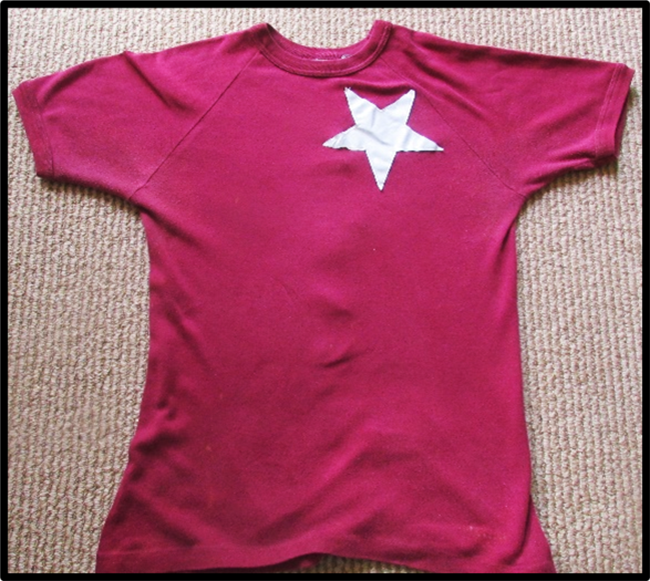
An original Begonia City Rowing Club t-shirt from 1975 with hand sewn star and number on the back. Begonia City took the same number as Ballarat City Rowing Club, the number 4 was adopted signifying the fourth club formed in Victoria. Crews from each club wore their club number on the back of their racing singlet. (From Kate Elliott’s memorabilia collection.)

This was the original letterhead paper for the new club featuring the begonia. It was the only visual reference to the name of the club as the club uniform featured a star and not a begonia. The begonia was chosen as it was the floral emblem of Ballarat and in the 1960’s and 70’s the Begonia Festival was one of the premier events for both residents and tourists. Ballarat was world famous for its begonia’s and it was often referred to as the Begonia City. As many of the early members worked for the City of Ballarat, it was appropriate to choose the floral emblem of the City of Ballarat for the new club.
DISCONTENTED SHOREBOUND GIRLS
Who were the two girls who set in motion women’s rowing in Ballarat? Most of this information and the letters and articles from the Ballarat Courier about the establishment of the club came from a scrap book of articles that Kim Butler had collected when she was a Ballarat High School student. By 1974, Kim was one of the last remaining original members had become custodian of the files of correspondence, newsletters and paperwork relating to Begonia City. Having been at the club since its inception, she had also collected a personal record of articles relating to the formation of the club. It is reasonable to assume that Kim and fellow student Lois Schmidt were the “Shore-bound girls”, since this letter featured in her collection. Their letter was not only the catalyst for bringing the sport of rowing for women to Ballarat but she and Lois both attended the initial training days and also signed up as foundation members of the club.
Kim and Lois trained and competed as a schoolgirl pair in Begonia City Ladies Rowing Club’s first regatta. Kim’s scrap book of these press clippings, were photocopied in 1975 by incoming secretary Kate Wise and the Begonia City files were passed on to her. The photocopies were fairly old and had deteriorated but they were sufficient as a starting point to research the current Courier archives. Unfortunately there were no dates on any of the articles so by working out the approximate month and scrolling through the archives of the Ballarat Courier for each month, enabled more exact dates and more photographs to be found to be added to the history. These form the basis of information about the early days of the club as no minute books appeared to have survived.

Lois Schmidt, stroke and Kim Butler, bow in their schoolgirl pair. Ralph Murphy, Ballarat City Rowing Club President, is the cox and coach.
Photograph from Ballarat Courier article January 1972.
GETTING TO THE START LINE
While it was two schoolgirls who first raised the possibility of having women’s rowing in Ballarat, there needed to be the input and interest of some adults who could take on the responsibility of forming a committee and drafting a constitution and actually running a club. In Ballarat, up until the University course for nurses was introduced in 1988, the Ballarat Base Hospital ran the Nurse’s Training Course. Young women who wished to take up nursing as a career, came and lived onsite in the Ballarat Base Hospital Nurse’s Home in Mair Street for the duration of their training. While there, they had classes and worked shifts in the hospital, including night shifts, hence the close proximity of the home close to the hospital. It was also just a short walk to Lake Wendouree. Many of the young nurses in their leisure time participated in the social and sporting life of Ballarat. Thus, when the VLRA held rowing clinics on the Lake, several of the nurses decided to become involved. In fact of the 40 or so members who signed up in the first six months, 10 were nursing students.
Glenda Sheers, was one of these and completed her training at the Base Hospital at the end of 1971. She was initially the organising secretary and would step up to become the first President of the new club and a very strong voice for women’s rowing. She, and the other founding members, were determined to provide an alternative to the traditional sports of netball and tennis that women had been limited to.
In an article in the Courier newspaper in September 1971, she expressed her disappointment at the lack of enthusiasm shown by the established male clubs in assisting the newly formed women’s club. It wasn’t so much the male rowers who were not accepting of the idea of women rowing, but the administrators, who came up with all sorts of reasons why women should not train out of the local clubs. In response Glenda was quoted in the Ballarat Courier stating:
“If we cannot get a boat in Ballarat we are confident the VLRA will find one for us…. And if the Ballarat clubs refuse us any space, then will try and find someone close to Lake Wendouree to offer us a yard big enough to store a boat.”
She would not be taking “no” for an answer and was determined to find a way to get the club established. Her “can do” attitude was precisely what the new club needed to achieve their goal and be able to row.
Along with the nursing students from the Ballarat Base Hospital, several of the girls who joined up, worked at the Ballarat Town Hall as secretaries and typists. The majority of members were school girls from Ballarat High School and later in early 1972, also several boarders from the Clarendon Presbyterian Ladies College, or CPLC, that was then located in Mair Street where the Ballarat and Clarendon Junior School is today. These girls were the first schoolgirls to row from what would become Ballarat Clarendon College. (Clarendon Ladies College amalgamated with Ballarat College in 1976 and became Ballarat Clarendon College.)
As all of the first members of the club were young women in their early twenties or still at school, the fact that they took on the somewhat herculean task of establishing the club with such enthusiasm and drive, is remarkable in hindsight. They were determined to succeed and succeed they did.

Graduating nurses from Ballarat Base Hospital 1971 from “History of Ballarat Base Hospital”.
Glenda Sheers is first on left of the second back row. Several other nurses who helped launch Begonia City Ladies Rowing Club are also pictured. Right hand side front row-Rita Koopmans also a BCLRC member.

Article from Ballarat Courier, September 30th, 1971.
THE FOUNDATION MEMBERS
The Courier reported in September that the club already had 24 members. There is on record the 17 nomination forms that were filled in at the first committee meeting on October 13th, 1971. This list is of the first members of the club along with their occupations taken from their original nomination forms.
- Glenda Sheers (student nurse)
- Lynda Gullock (student)
- Margaret Gartside (trainee nurse)
- Lois Schmidt (student)
- Judith Sullivan (student nurse)
- Susan Barrett (student)
- Judy Carter (student nurse)
- Kim Butler (student)
- Pamela Ford (student nurse)
- Irene Hatt (clerk) Ballarat Town Hall
- Carolyn Johns (student nurse)
- Jan Madin (stenographer) Ballarat Town Hall
- Karen Jones (shop assistant)
- Delwyn Milne (student)
- Denise Moroney (student teacher)
- Anne Netherway (student)
- Kaye Rizzoli (student)

Copy of the original membership application forms. Jan Madin’s original nomination form signed by the club secretary Carolyn Johns. All the first members registered their membership at the committee meeting on the 18th of October 1971.
Jan Madin was the first Captain of Begonia City Ladies Rowing Club from inception until the end of 1974. Jan worked at the Ballarat Town Hall as a stenographer or secretary. Carolyn Johns, also a student nurse, was elected secretary at the first meeting of the club. The ladies obviously copied the format from the men’s club as there is a quaint reference to never having competed in a race advertised for watermen. In Ballarat, it had been over a hundred years since any race was advertised for professional watermen and to my knowledge in Victoria, at least, no woman was ever employed as a waterman!
FIRST COMMITTEE ELECTED
OFFICE BEARERS-SEASON 1971-72
PRESIDENT: Glenda Sheers (August 1971-January 1972), Pam Johns (January-September 1972)
VICE-PRESIDENT: Denise Moroney
TREASURER: Kaye Rizzoli
SECRETARY: Carolyn Johns (August-November 1971), Irene Hatt (November 1971-September 1972)
CLUB CAPTAIN: Jan Madin
HON AUDITOR: Mr. C R James
Glenda Sheers was initially secretary/organiser of the new club and was elected as President at the club’s first meeting. She steered the club through the first challenging months and was in office from August, 1971 until January 1972. Then after only six months at the helm, and all her efforts to get the club up and running, negotiating a home and equipment for the fledgling club, she had to step down due a transfer in her nursing career. Pam Johns was then elected to the position and led the club through the rest of the first season of rowing. Vice-President was Denise Moroney and Treasurer was Kay Rizzoli who joined, along with her sister Joy, who also competed together in pairs and fours for two seasons. Carolyn Johns was secretary for three months, until she too had to move due to her nursing career and Irene Hatt took on the role for the rest of the season. Jan Madin was the club’s first Captain. Both Jan and Irene worked together as secretaries and the Ballarat Town Hall.
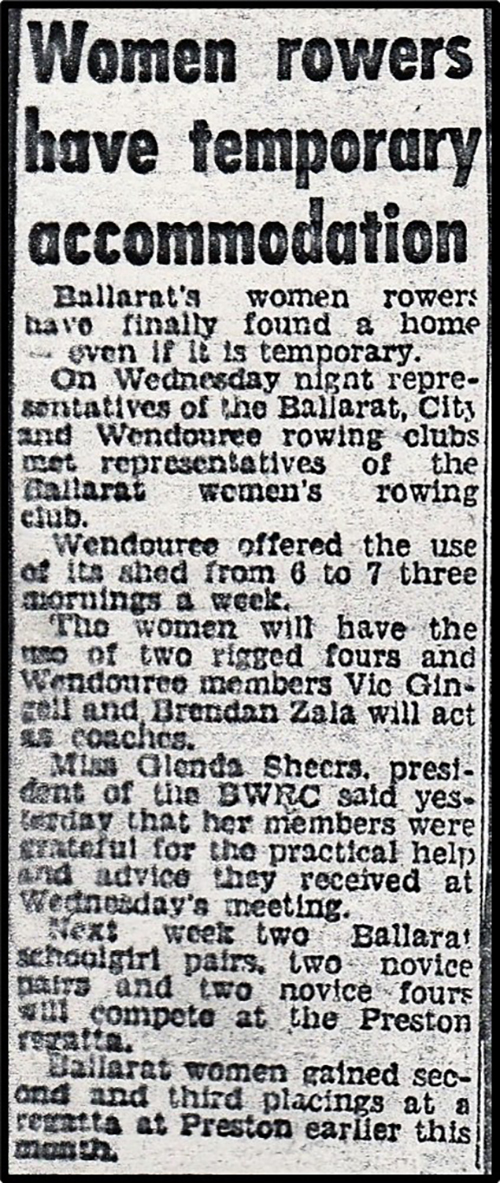
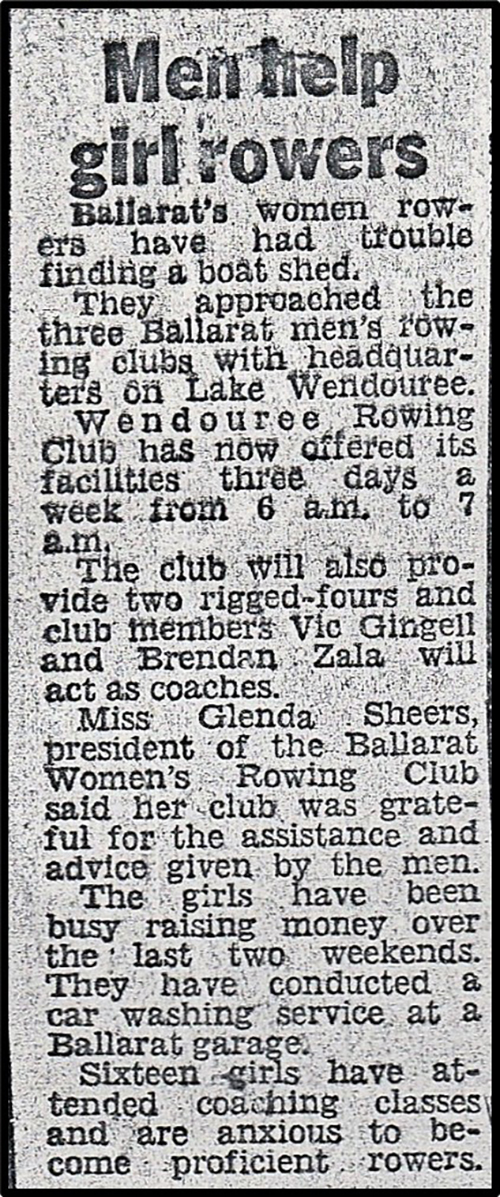
One of the most important achievements of Glenda Sheer’s presidency was to secure a permanent base for the club. Having sent out letters to all three of the men’s clubs asking for their assistance, she and her fellow officers met with Ballarat City Rowing Club and Wendouree Rowing Club to discuss where the women might conduct their rowing. Both Ballarat City and Wendouree also offered assistance and issued invitations to their respective Open Days. Wendouree Rowing Club offered its facilities from 6am-7am three days a week with Vic Gingell and Brendan Zala to provide coaching while Ballarat City’s offer made the club and equipment available five days a week after 5pm.

The women rowed for a short while from Wendouree Rowing Club. However it didn’t take long for the committee of the Ballarat City Rowing Club to realise the benefits of hosting the women. It would enable the club to effectively double the population from which it could draw members. In later years, if not for having the foresight to include women in the club, it would have been in very desperate straits indeed. At the Ballarat City Rowing Club’s Annual Meeting on the 24th of September, Frank Findlay was elected President for his 21st term.
At the BCRC committee meeting on 12th October, the correspondence was received from the newly formed Begonia City Ladies Rowing Club requesting assistance with equipment and coaching. Norm Angow moved that the men’s club contact the women and offer to meet with them and discuss how they might be of assistance. This was a very difficult time for BCRC as memberships were falling and the President Frank Findlay, was looking at amalgamation with Ballarat Rowing Club, who were also struggling with falling memberships and rising costs. BCRC was also negotiating with Ballarat College to rent out space in the boatshed as their old shed had been condemned and they needed somewhere to row.
At the Ballarat City Rowing Club committee meeting in November, Ted Edwards reported on the meeting with the “ladies”. It must have been positive meeting as Rob McGuire and Alan Dixon moved and seconded a motion that the club invite Begonia City Ladies to Open Day and confirm the offer shed for training Monday through to Friday at 5pm. A special meeting was convened for Sunday, November 14th to discuss the girls joining the club. In the minutes it is recorded that they were also going to paint the kitchen at the same time!
At this Special Meeting, the secretary reported that Begonia City Ladies Rowing Club had accepted the offer of attending Open Day and also the offer of training from the club’s boatshed. The offer was formalized in a letter and it was to be reviewed in January 1972. The Begonia City Ladies were also informed that the “care and tidiness of the club house and the equipment would be their responsibility.” This was moved by Norm Angow and seconded Ted Edwards and carried. The date of Open Day was set for December 5th at 2pm with racing to be held in mixed fours followed by a BBQ.
While the minute books of the day record the facts of the motion to include women in the club, it does not record the level of high feeling and division that occurred around this. When the motion to have Begonia City Ladies rowing from the Ballarat City shed was carried, it caused an almost cataclysmic event that shook the men’s club to its very foundations and bought it kicking and screaming into the forefront of support for women’s rowing. The story often repeated by older members, was that at this point of the meeting, President Frank (Cobber) Findlay announced that if women were admitted to the club then he would leave. The minute book records that in General Business Mr. Findlay excused himself from the meeting and left the room. Mr. Ted Edwards, the Vice-president took the chair and read “Cobber’s” letter of resignation as President of the club!
The meeting, after some discussion, resolved to hold over the resignation until Mr. Edwards had had a chance to discuss it with Mr. Findlay. Frank Findlay must have known that he couldn’t stop the vote and so drafted his letter of resignation maybe in the hope that the shock of losing their long time President would force the club to reject the women and retain his services. Colin Angow, a current BCRC Life member, remembers that he and Daryl Calvert, who were young coxswains at the time, went upstairs and saw Frank leaving. He said “Goodbye boys.” and that was the last they ever saw of him. It was unfortunate that he did not see that having women as members actually addressed the issue of declining memberships that he cited at the Annual Meeting. The kitchen did not get painted that day as had been planned and I suspect the sky grew dark and the earth trembled-just a bit.
A second Special Meeting was held on the 23rd of November to now deal with the imminent departure of the President. There were 28 members present. Frank Beattie moved that Frank Findlay’s resignation be accepted and a letter of thanks forwarded to Mr. Findlay. It was seconded Ralph Murphy and with that the club saw the departure of one of its most dedicated presidents. A letter of thanks was sent and the committee was to arrange a suitable presentation. Frank Findlay had given the club over twenty years of dedicated service, he had used strong tactics when strong tactics were needed. He had overseen the rebuild after the disastrous 1950 fire; he had been President of the Ballarat Rowing Association assisting with the running of the 1956 Olympic rowing on Lake Wendouree. He had, in short, ensured the survival of the club and kept Ballarat City to the fore. But he was unable to accept the inclusion of women in the club, a move that would ultimately solve many of the club’s financial and membership woes! Mr. Findlay’s resignation left the club without a president. Once again that stalwart gentleman, Mr. Ted Edwards accepted the nomination and again led the club through a challenging time.
And so the women, championed by Norm Angow, Ted Edwards, Frank Beattie and Ralph Murphy, were successful in securing a home base, access to equipment and coaching. Begonia City would have very little impact on the administration of the club initially. It was a case of being seen but not heard! But at least they had taken the first step in firmly establishing women’s rowing in Ballarat.
Opening Day in December ’71, proved to be a unique affair and the biggest Open Day ever. Over one hundred people from the two clubs, Ballarat City and Begonia City, attended and for the first time mixed fours were raced. The ladies were racing themselves instead of “nominating” a male rower to compete for them.

Headline from Ballarat Courier, December 1971
Trophies for Open Day were donated and presented by Mr. Ted Edwards, club stalwart and supporter of Begonia City Ladies and Mrs. Dorothy Angow, wife of Norm Angow, who along with Ted Edwards had been so crucial to getting Ballarat City to host the women’s club. The article on the left refers to the “most novel” event being the mixed fours with the women from begonia City ladies rowing in stroke and three seat with two oarsmen in two seat and bow. The members of that first ever winning combination crew were two young ladies who were founding members of Begonia City, Denise Moroney and Irene Hatt. This was vindication, if it was needed, that this had been the right decision for Ballarat City!

Quarterly meetings of Ballarat City Rowing Club were resumed, giving all members a chance to have input to the running of the Club. A “Student membership” was introduced to encourage both secondary and tertiary students to take out memberships. Ballarat College were also rowing from the shed because of the dilapidated condition of their shed (the original shed over near St. Pat’s) Mr. Frank Ritchie was rowing Master and College won the Head of the Lake and the Premiership. The Annual Report congratulates them not only on their wins but also for the boys’ excellent behaviour while guests in our shed. The Ballarat City boatshed had again become a thriving hub of rowing activity.
Given that quite a few of the new Begonia City Ladies were students at Ballarat High School and offer was made to the school of boats and facilities for schoolgirls to row, however the response from the school was that the sporting curriculum was still too full to include rowing for girls. Although Ballarat High School did not take up the offer this time, in later years Ballarat City Rowing Club did loan equipment and provide coaching for High School girls and many, if not all the High School rowers went on to become members of the club.
In four short months of existence, the hardworking committee of Begonia City Ladies had achieved the goals of forming a club, find a home, accessing equipment and signing up thirty or so members. They had held fundraising events including carwash at a local garage for two weekends during October. This helped to consolidate their financial position. As the President said in her report, they had:
“….in every way socially, financially and in training and racing progressed the club.”
They had competed at various regattas and were ready to take on the next challenge of running their own regatta. This was organised in mid-December 1971 and was to be held in February 1972, when the VLRA offered the club the 6th of February. This date had been allocated to the Morwell Ladies club but they were unable to run the regatta then.

Ballarat Courier, 16th December 1971
Once again the new club was up for the challenge and sought help from the Ballarat Rowing Association, in order to run the regatta. With training during the week and weekends taken up with racing or fundraising, it was a very busy and exciting time for the club. They had taken on every challenge and done their utmost to see the club succeed.

1971 REGATTAS AND RACING
1. Preston Regatta, 9th October. First regatta attended by Begonia City Ladies. Racing in borrowed boats. Two Schoolgirl pairs-Lois Schmidt, Kim Butler and Kay Rizzoli, Joy Rizzoli. Two Novice pairs-names unknown. Two novice fours-names unknown (possibly the two schoolgirl pairs combined and the two novice pairs combined. Placings 2nd and 3rd in heats.
2. Ballarat City Rowing Club Open Day- 12th December. Mixed fours-winning crew Denise Moroney (stroke), Irene Hatt (3), I. Smith (2), Phil Dixon (bow).
3. Wendouree Rowing Club Open Day- December. Ladies Invitation fours- 3 Begonia City Ladies Rowing Club crews raced against each other with the four of Pam Johns (bow), Carolyn Johns(2), Irene Hatt (3) and Jan Madin (stroke) first place.
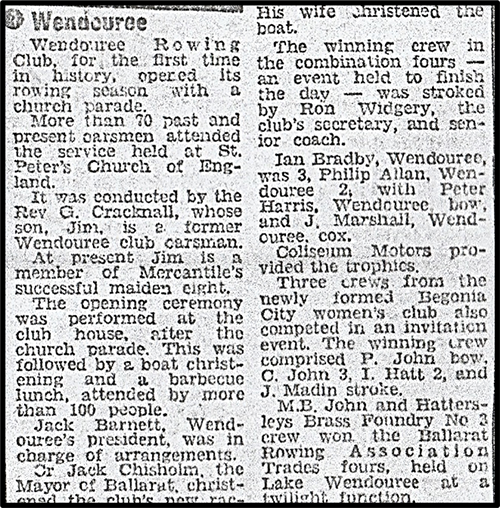
Article from the Ballarat Courier, Wendouree Rowing Club Open Day, 1971
4. Ballarat Rowing Association, Trade Fours twilight regatta December-invitation women’s fours. Irene Hatt (bow), Liz McGrath (2), Sue Barrett (3) and Jan Madin (stroke) first place.
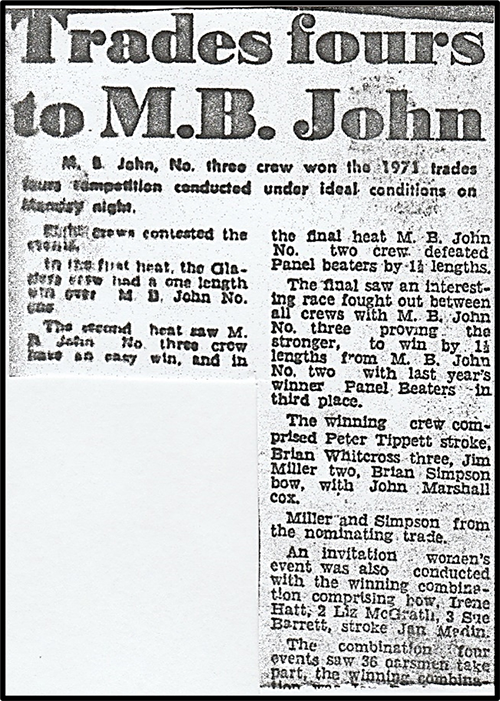
Article from Ballarat Courier, November 1971, Trade Fours Regatta women’s invitation race.
*Note: The Trade Fours Regatta was held annually with crews from various trades in Ballarat competing for the Trades Four Cup.
5. YWCA, Albert Park Regatta, 13th December 1971-crews not recorded. Reported that they raced at this regatta in Courier article on 16th of December.
Jan Madin- first Captain, Begonia City Ladies Rowing Club.
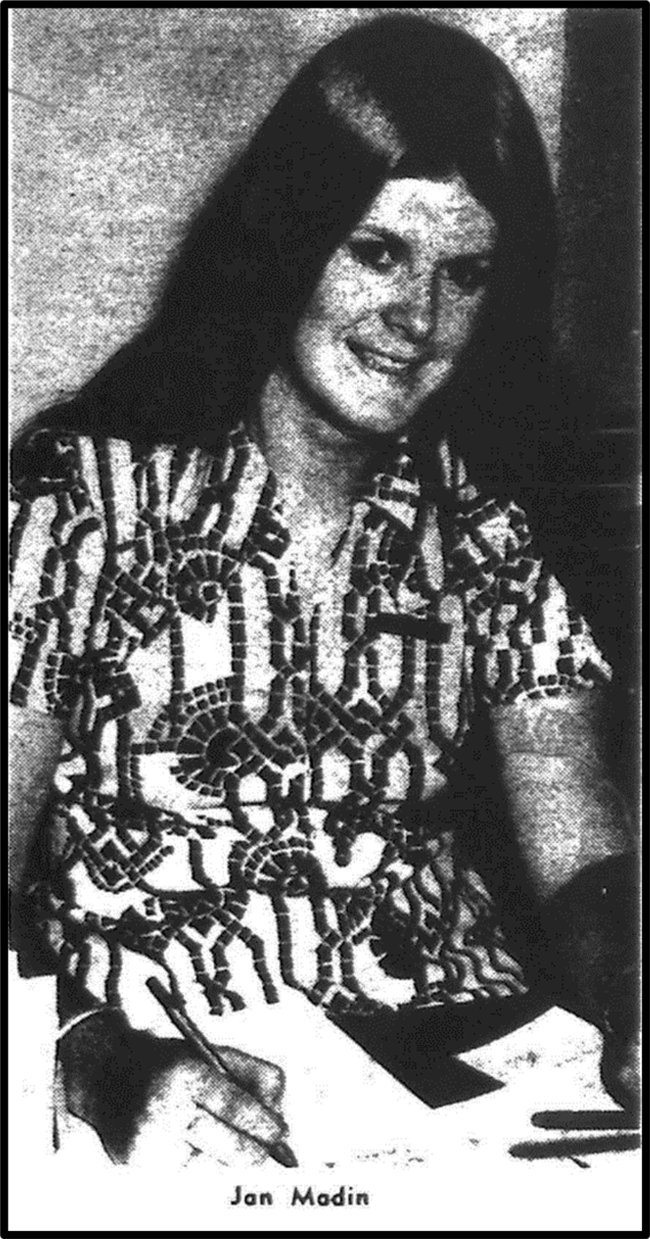
A work friend of mine Irene Hatt mentioned one day at work that she was going to try rowing. Ballarat City had advertised for any ladies interested in trying the sport to come along. Irene and I went up to the boatshed on the designated day after work. The wind was blowing fiercely from the west and the waves were breaking over the jetty. We naively assumed that as we had come to try we would simply pick up a boat and proceed. The first person we met was Graeme Angow, then the club captain. Graeme quickly said that there was no way we could go out in such rough water and showed us around the boatshed.
There were a dozen or so interested potential rowers who initially turned up to learn. The club organized Kath Suhr(now Bennet) from YWCA Ladies Rowing Club on Albert Park Lake to come and talk to the new recruits. She told us the process of getting the club up and running and invited all the girls down to row on the Yarra one Sunday. This we did even though once again it was a very windy day and very unpleasant rowing conditions!
Despite battling the elements and the very much male dominated sport we decided to form a club. We elected office bearers and I was elected Captain of Boats. Irene was the treasurer. Unfortunately we don’t have any of the minute books that would have chronicled our early endeavours. We adopted the name “Begonia City Ladies Rowing Club” and a uniform of white shorts and maroon t-shirts with a white star.
We didn’t have our own equipment and had to use the oars the men used. Early in 1972 we decided we would hold a fundraiser to purchase more suitable oars. The mayor of the time Cr.Jack Chisholm was incredibly supportive of our efforts and he suggested that for our fundraiser he would open the Town Hall for an “At Home”evening. I and my workmates acted as guides for the evening and supplied supper and the residents of Ballarat paid to meet the Mayor and tour the Town Hall! We were overwhelmed by the support of the community and underestimated the number of people who turned up to have a look through the Town Hall. From this evening we made enough to purchase two sets of four oars-with the blade painted white with a maroon star. They were made by Jeff Sykes of Geelong and were smaller and lighter to suit women’s crews. We were so proud of those oars-imagining owning your own oar!
I really enjoyed training but found lifting the boats out of the water difficult especially as the boat we were allocated always weighed far more coming back from a training row than it did when we went out-it leaked and consequently had to be lifted out partially filled with water! Hence the weight increase! There were two fours we were allowed to use a light colored one called BLONDIE and a darker one called DAGWOOD. Given the popularity of the cartoon of this name at the time it was obviously some wit around the club who christened them this! We used to train every night and occasionally in the early morning and then go away and race somewhere on the weekends. We all appreciated the help we had from the Ballarat City men especially the time spent coaching and just teaching us to row.
We travelled away to regattas including Yarrawonga, Warrnambool, Albert Park Lake (Melbourne), Lake Edwards (North Melbourne) and the Yarra River. I stroked our four. Women’s’ regattas were run separately to the men’s’ regattas under the auspices of the VLRA. We only ever won one race at Warrnambool. Our trophy-a china plate!
Our regatta at Lake Edwards was also very memorable as it was such a small lake the distance we rowed was about 300 metres. All the clubs at regattas were very helpful and encouraging loaning boats and oars to support us as a new and developing club. We still didn’t have sufficient numbers to be able to take boats to regattas and still had to share boats with the men at the club.
We ran our own successful regattas on Lake Wendouree with all novice races being 500 metres and senior races 1000 metres. At one of our regattas the weed was a real problem on the course. So again my workmates at the City Council assisted the club to run the regatta on the old course from Haddon Street to View Point. The Council surveyed and marked the course out for the club. It proved to be an excellent course especially for the spectators as the entire race could be seen from the lakeside path.
When writing the history of Ballarat City Rowing Club, “The Boys from the Rushbeds-the History of Ballarat City Rowing Club 1870-2004”, Jan (Madin) Falla contributed her memories of the beginnings of Begonia City Ladies Rowing Club. She added valuable information relating to the early days and confirmed that, unfortunately, none of the early minutes of meetings survived to serve as a record of the club’s activities. This is the transcript of Jan’s letter from 2004 with her memories of those early days.

